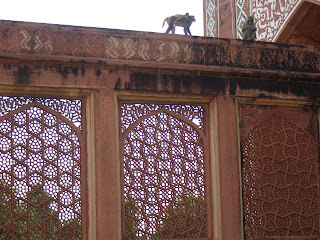In Rajasthan folk tales Mughal Emperor Akbar is a capricious and bizarre man with incomprehensible desires and absurd commands. It is Birbal, his wise and patient minister, who solves all situations with brilliant ideas and great courage making the emperor laugh of his own fool requests. In history books, Akbar is the grandson of Babur, the first Mughul emperor who conquered North India around 1526 coming from Kabul. Akbar is described as a strong, fearless and energetic man who fought to expand his empire that, at his death in 1605, extended from the Himalayan Mountains in the North to Godavari River in the South. He worked hard to strengthen and organize a huge territory, providing solid bases that would last in the following centuries. He was interested in culture, a skilled artisan and a curious and enthusiastic inventor. He enjoyed life and its pleasures above all during his youth becoming more restrained as he grew old. He was illiterate but knew the heart of men and knew how to obtain obedience, respect and love.
This man is buried in a peaceful and sacred garden, completed around 1613, at Sikandra some ten kilometers west of Agra.
I visited it in August. It was not crowded, just few Indian families who left rupees, yellow flowers and prayers on the tomb. Then, they walked back along the paved walkway glancing deer in the lawn and sudden flights of birds over tall trees. They exited from a red sandstone gate where monkeys run along the top and jalis broke light in geometrical splinters. Calm and silence.
 The gateway is a majestic arch that frames recessing smaller ones built one above the other. They are replicated on each side, in closed balconies, creating a square building edged with crenellations and chhatris. Red sandstone disappears under a rich decoration of floral marble inlays and geometric mosaics made of colored stones. For the first time, Persian style inscriptions were designed along the surface. The famous calligrapher Adb al-Haqq Shirazi (called Amanat Khan), who later decorated the Taj Mahal, chose elegant characters to celebrate this garden as an earthly paradise and to remind the glory of Emperor Akbar and his son Jehangir. At each corner of the building, four white marble minarets topped with chattris stand slender and pure.
The gateway is a majestic arch that frames recessing smaller ones built one above the other. They are replicated on each side, in closed balconies, creating a square building edged with crenellations and chhatris. Red sandstone disappears under a rich decoration of floral marble inlays and geometric mosaics made of colored stones. For the first time, Persian style inscriptions were designed along the surface. The famous calligrapher Adb al-Haqq Shirazi (called Amanat Khan), who later decorated the Taj Mahal, chose elegant characters to celebrate this garden as an earthly paradise and to remind the glory of Emperor Akbar and his son Jehangir. At each corner of the building, four white marble minarets topped with chattris stand slender and pure.Beyond this gate is Akbar’s mausoleum, a place called Bihishtabad, or The Abode of Paradise. And hints of paradise are everywhere.
Mughals celebrated their power with buildings where architectural elements told about their divine origins. Fascinated by the mystery of religions, Akbar went further unifying in his own religion, called Din-i-Ilahi the Religion of God, elements and aspects of the different beliefs present in his empire. He preached tolerance, kindness and purity. He introduced new rites at court exalting the divine nature of his person: a descendant of the Sun illuminated by the light and knowledge of God. Religion legitimated his absolute power and increased loyalty. He was a wise ruler who, with the help of valuable ministers, organized a centralized administration, a solid fiscal system and an efficient army. Order and geometry expressed imperial power in the net of roads and towns developed to support agriculture, small manufacturers and commercial exchange as in the architecture of palaces and gardens.
- to be continued -
Further reading:
Maria Grazia Cella, Favole del Rajasthan, 1992, Arcana Editrice – Milano
translated from Birbal ki kahaniya (Birbal’s tales)
Ebba Koch, Mughal Architecture, 1991, Oxford University Press
Francis Robinson, The Mughal Emperors and the Islamic dynasties of India, Iran and Central Asia, 2007, Thames & Hudson Ltd, London
Attilio Petruccioli, Fathpur Sikri La capitale dell’impero Moghul, la meraviglia di Akbar, 2007, by Mondadori Electa S.p.A., Milano
Internet links:
ArchNet online resourch focused on Muslim culture and civilisations
https://archnet.org/lobby/
Mughals celebrated their power with buildings where architectural elements told about their divine origins. Fascinated by the mystery of religions, Akbar went further unifying in his own religion, called Din-i-Ilahi the Religion of God, elements and aspects of the different beliefs present in his empire. He preached tolerance, kindness and purity. He introduced new rites at court exalting the divine nature of his person: a descendant of the Sun illuminated by the light and knowledge of God. Religion legitimated his absolute power and increased loyalty. He was a wise ruler who, with the help of valuable ministers, organized a centralized administration, a solid fiscal system and an efficient army. Order and geometry expressed imperial power in the net of roads and towns developed to support agriculture, small manufacturers and commercial exchange as in the architecture of palaces and gardens.
- to be continued -
Vocabulary:
Chhatri: or umbrella, a small domed kiosk supported on columns
Jali: perforated stone screen with ornamental design
Further reading:
Maria Grazia Cella, Favole del Rajasthan, 1992, Arcana Editrice – Milano
translated from Birbal ki kahaniya (Birbal’s tales)
Ebba Koch, Mughal Architecture, 1991, Oxford University Press
Francis Robinson, The Mughal Emperors and the Islamic dynasties of India, Iran and Central Asia, 2007, Thames & Hudson Ltd, London
Attilio Petruccioli, Fathpur Sikri La capitale dell’impero Moghul, la meraviglia di Akbar, 2007, by Mondadori Electa S.p.A., Milano
Internet links:
ArchNet online resourch focused on Muslim culture and civilisations
https://archnet.org/lobby/
